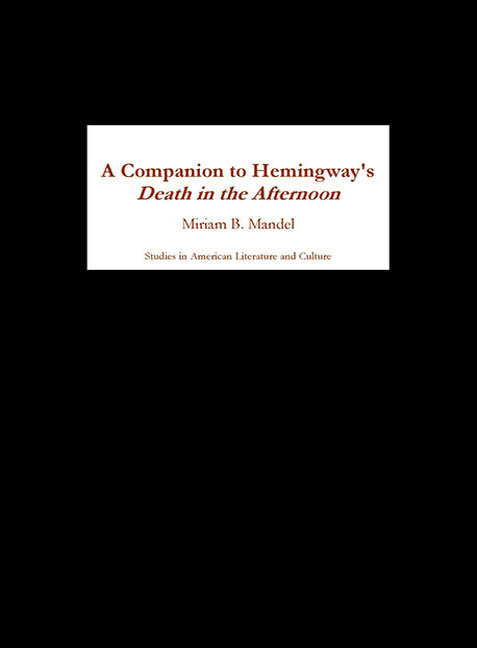Book contents
- Frontmatter
- Dedication
- Contents
- Acknowledgments
- Hemingway Works That Address the Bullfight
- A Note on the Text of Death in the Afternoon
- Introduction
- Composition, Sources, and Backgrounds
- The Composition, Revision, Publication, and Reception of Death in the Afternoon
- “Devout Again by Cynicism”: Lord Byron and Don Juan in Death in the Afternoon
- “I like you less and less”: The Stein Subtext in Death in the Afternoon
- Subject and Author: The Literary Backgrounds of Death in the Afternoon
- Reading Texts, Paratexts, and Absence
- On Authorship and Art
- And What Came After
- Works Cited
- Notes on the Contributors
- Index
Subject and Author: The Literary Backgrounds of Death in the Afternoon
from Composition, Sources, and Backgrounds
Published online by Cambridge University Press: 27 April 2017
- Frontmatter
- Dedication
- Contents
- Acknowledgments
- Hemingway Works That Address the Bullfight
- A Note on the Text of Death in the Afternoon
- Introduction
- Composition, Sources, and Backgrounds
- The Composition, Revision, Publication, and Reception of Death in the Afternoon
- “Devout Again by Cynicism”: Lord Byron and Don Juan in Death in the Afternoon
- “I like you less and less”: The Stein Subtext in Death in the Afternoon
- Subject and Author: The Literary Backgrounds of Death in the Afternoon
- Reading Texts, Paratexts, and Absence
- On Authorship and Art
- And What Came After
- Works Cited
- Notes on the Contributors
- Index
Summary
Life is too short to learn bullfighting.
A Castilian gentlemanReaders come toDeath in the Afternoon for two major reasons: they are interested in its subject, or they are interested in its author and his art. The first group ranges from tourists preparing for a trip to Spain, to serious students of the bullfight, and to other scholars whose interests somehow or other lead them to the bullfight. The bullfight might, for example, become an important concern to students of Goya's paintings, Benlliure's sculpture, García Lorca's poetry, DeFalla's music, and Bizet's operas. The bullfight is also germane to the study of urban architecture, medieval jousting, material culture, the history of aggression, crowd psychology, genetics and selective breeding, violence and the ethics of violence, legal codes, folklore studies, marketing and advertising, and the influence of the Roman Catholic church. Historians of publishing who are interested in translations, bilingual publications, illustrated publications, transcultural studies, travel writing, biography, autobiography, technical manuals, lexicography, or authorship would find rich materials within the extensive literature of bullfighting. That is, a variety of areas of interest might lead readers to the bullfight, and to read about the bullfight is to come in contact with Death in the Afternoon.
As a treatise on bullfighting, Death in the Afternoon has practically no rival. In Spain, it was immediately recognized as a significant work. Spain was well-aware of foreign interest in the bullfight, as evidenced by titles like “En beneficio de los extranjeros” (1899) and Los ingleses y los toros (1926). But these were humorous and pedagogical pieces, nothing like the respectful review, by one of Spain's leading taurine critics, that hailed Death in the Afternoon as “algo extraordinario, muy merecedor de los mayores encomios” (an extraordinary book, worthy of the highest praise). Among those who know the subject, that evaluation still holds.
Death in the Afternoon has been translated more frequently than any other book on the bullfight (into eight languages, at last count), and it dominates subsequent literature on the subject. In 1957, Angus McNab recognized that “After twenty-five years, Mr. Ernest Hemingway's Death in the Afternoon remains the standard work of literature in the English language on the subject of bullfighting, and it is difficult to see how it could well be dislodged from that position.
- Type
- Chapter
- Information
- A Companion to Hemingway's Death in the Afternoon , pp. 79 - 120Publisher: Boydell & BrewerPrint publication year: 2004

